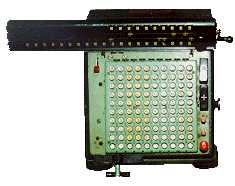The Monroe Mechanical Adding-Calculator
While pinwheel and stepped drum machines were excellent for multiplication and division, the adding machine was better for addition and subtraction. The keyboards of adding machines made for faster data entry than the levers of the pinwheel and stepped drum machines. A number of companies designed machines which combined the advantages of each type. They had keyboards for fast data entry but and shiftable carriages for easy multiplication and division. Monroe was one of the earlier companies to design such a calculator in 1911 using a new mechanism. (The design was done by Frank Baldwin who previously invented the pinwheel calculator.) The model shown has a full keyboard for numeric entry. The crank on the front shifted the carriage back and forth. The large crank on the side performed addition and subtraction depending on which direction it was turned and the smaller crank on the carriage zeroed the registers. (Which register was zeroed was determined by the direction the crank was turned.) Like adding machines, this machine could clear the input digits on each addition. The numbers were cleared if the R (repeat) button was not down. (The blank button raised the repeat button.) The large 0 button in the lower right cleared the entire keyboard. Individual digits could be cleared by pressing the blank keys in each column." |
Source: System Source - Computer Museum |
